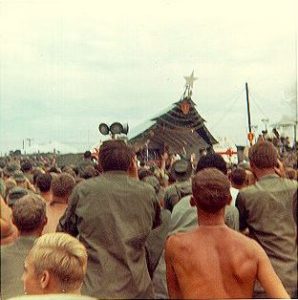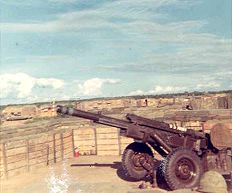We survived primarily on C-Rations. Some of the “entrées” weren’t too bad, particularly if you had a way to heat them. Occasionally, I would punch a hole in the can, then place it near the exhaust on the generator. I thought the canned Spaghetti was decent, particularly if hot. On the other hand, the Ham & Lima beans were absolutely horrible. The ingredients had been in the can together for so long the only way you could tell them apart was by their shape. And the Lima Beans were incredibly stringy. You could chew on that crap for 5 minutes and accomplish nothing. Lowest bidder, I’m sure. I usually fed it to the nearest dog.
Each C-Ration meal also came with 4 cigarettes, a tin of crackers or pound cake, canned fruit and a few sheets of toilet paper. I’m being generous when I say toilet paper. It was more like newspaper, but without the news.
When we were fortunate enough to be based at or near an American FSB, we could usually mingle in the chow line with the gun crews and infantry. The field cooks actually turned out some pretty decent chow, considering the harsh conditions. Even BBQ beef on occasion. I always made it a point to bring a couple of cartons of milk back with me. In the evening, I fired up a small hot-plate (stealing a few watts from our radar generator) to heat the milk in my canteen cup. When hot, I added powdered chocolate from our C-Rations and enjoyed a nice little treat. Small comforts helped saved my sanity, I think.
There was one time when being close to hot chow almost turned out to be a bad thing. We spent 2 weeks at the base camp in Tay Ninh and had crowded into a bunker with an existing Q-4 counter-mortar radar team while we constructed our own bunker. The chow tent was about a block away and man, were we enjoying that. One morning, two of my teammates gave me a nudge as they headed out to breakfast. “Come on Staff, chow!” and off they went. I pulled on my boots, grabbed my boonie hat and started for the bunker door. Just as I was reaching for the screen door a rocket hit the dirt road right out front. Wham! The blast knocked me backwards. There was no warning. It just hit. I got up, ears ringing, then I started thinking about my buddies who just headed out. I ran out the door and looked down the road. Both were on the ground, but seemed to be OK. They hollered to me to find out if I was OK. Yeah, no red stuff leaking out.
Later, we examined the impact area. To my very good fortune, some unknown person had parked a trailer-mounted generator on the edge of the road, nose (hitch) down in the dirt. The wheel was not extended. The rocket hit right on the other side. The trailer and generator engine block stopped most of the shrapnel coming my way. Still, we did find quite a few holes in the bunker sandbags near the door and in the low blast wall in front of the door. I was completely exposed from about the navel up. I really lucked out. I was only going to breakfast.
As I have mentioned elsewhere on this website, we spent 3+ months at an ARVN Infantry camp near Loc Giang. There was an American Advisory team there also who trained and led the ARVN’s. The odd/interesting thing about this ARVN camp was that some of the soldiers had their families with them. From my experiences, it was rare to see civilians and families camped out at a combat base. And this did lead to some problems.
The ARVN were pretty poor, even when compared to us. This resulted in much theft of our supplies including C-Rations, gasoline and even personal items. Despite that, I did share some of our C-Rations with the children. Obviously, they were very hungry.
One day I gave into temptation and bought what resembled a submarine sandwich from a Vietnamese civilian just outside the gate of our camp near Go Dau Ha. I also bought a bottle of Coca-Cola, labeled in French. That little mistake cost me 2 weeks of the trots. I later learned that the meat in the sandwich was not pork or chicken. Or Water Buffalo. That didn’t leave too many options…






